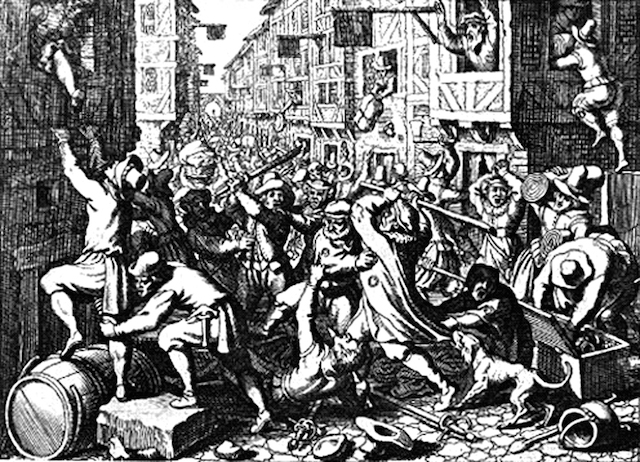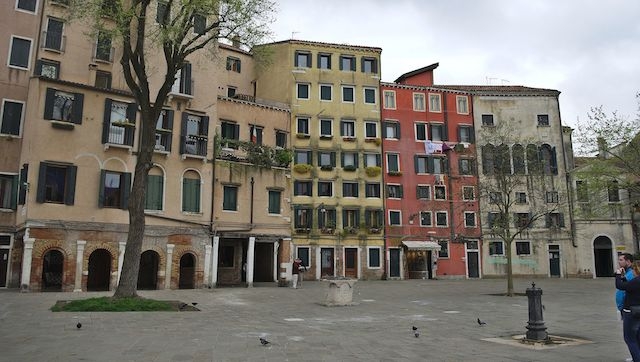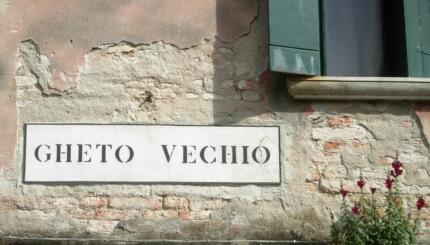The “ghetto” refers to an enclosed place where European Jews were once relegated to live.
The term, derived from the Italian gettare, which refers to the casting of metal, was first used in Venice in 1516, when authorities required Jews to move to the island of Carregio (the Ghetto Nuovo, new ghetto), across from an area where an old copper foundry was located (the Ghetto Vecchio, old ghetto).
The ghetto in Venice was enclosed by a wall and gates that were locked at night. Jews had to observe a curfew, and were required to wear yellow hats and badges to distinguish themselves, a practice that the Nazis would later adapt in the 20th century. The ghetto in Venice was crowded, and therefore it was necessary to add new floors onto existing buildings, leading to the first so-called skyscrapers. While the 1516 law creating the ghetto limited Jews’ freedom of mobility, to some degree it was less severe than policies elsewhere in Europe, where Jews were often forced to leave altogether. Inside the confines of the ghetto, Jews had the autonomy to govern themselves and to sustain their own social, religious and educational institutions.
Though the term “ghetto” was first used in Venice, this was not the first instance of Jews being forced into segregated quarters. Compulsory segregation of Jews was common in medieval Europe, and these Jewish areas were later referred to as ghettos. The Lateran Councils of 1179 and 1215 advocated for the segregation of Jews. A ghetto-like community existed in 1262 in Prague, and by the 1400s became more common in other European cities. In 1460 the Judengasse (“Jews’ Alley”) in Frankfurt was established.
With your help, My Jewish Learning can provide endless opportunities for learning, connection and discovery.

In 1555, Pope Paul IV issued the “Cum nimis absurdum” proclamation, which required the Jews of Rome to live in separate quarters and also severely restricted their rights, including what businesses they could engage in. The purpose of this edict was to encourage conversion to Catholicism, an act that would serve as a ticket out of the ghetto. The ghetto made a clear distinction to the wider society between those who were accepted” and those who were not. Though anti-Semitism was alive and well in the centuries that preceded this papal order, until 1555 the Jews of Rome had enjoyed freedom of movement. Under the papal order, they were relocated to a crowded and unsanitary area that regularly was flooded by the Tiber River. While the ghetto was a place of squalor, the rest of the city was being built up with magnificent churches. This contrast allowed the authorities to highlight the differences between Jews and Christians, making it seem as though the destitute living conditions of the ghetto were the natural consequences of denying the divinity of Christ. Though the ghetto was designed to segregate Jews, who were seen as a threat to Catholicism, it did not stop Jews and Christians from maintaining social and economic interactions; indeed Christians were allowed to enter the Roman ghetto during the day.
In the 18th century, as part of a broader effort to spread liberty and equality, Napoleon sought to liberate the Jews from the ghettos of Italy. In one instance, in Padua, the French emperor even declared that the street where the Jews lived be renamed in order to remove the word “ghetto.” Nevertheless, the Jewish ghetto in Rome was hard to eliminate. Even though the gates were taken down in 1848 (due to protests by Roman citizens allied with Jews), the ghetto did not officially cease to exist until 1870, when Italy was unified and became a modern nation state. This period of Jewish emancipation (beginning in the late 18th century, continuing through the early 20th century) led to the dismantling of ghettos across Europe.

Though by the 20th century Jews were no longer forced to live in ghettos, many continued to live in segregated quarters, in cities throughout Europe and the United States, including Warsaw, Prague, Frankfurt, the Lower East Side of Manhattan and the West Side of Chicago. Writers in the 20th century described many of these neighborhoods as slums, filled with poverty, violence, and iniquity.
In the 1930s, Nazi Germany reintroduced ghettos in the areas under its control, adding the notorious laws that would restrict Jews’ basic human rights and laying the groundwork for future deportations and the horrors of the Holocaust.
The term “ghetto” eventually was reappropriated to refer to poor, urban African-American neighborhoods, but was later deemed offensive, now often euphemized by the term “inner city.”



